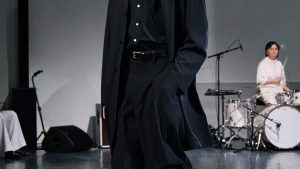
Ami Spring 2026 Menswear
“My fortune teller hasn’t slept since the last three nights. She prayed to push back the rain. It worked!” Alexandre Mattiussi was speaking in the porte cochere of Ami’s HQ on Rue Etienne Marcel. The little space was packed almost to capacity—but with a little more room once the final pushy trio of bodyguard + agent + “VIP”—had exited after completing posing duties with the designer. The reason we were jammed in so tightly was that Mattiussi’s fortune teller’s impressive powers could only delay the inevitable for so long: outside was thunder, lightning, a gale, and rain that seemed almost solid.
“This is my favourite collection!” said Mattiussi: “Because we are at home. This is my building, my neighborhood, my friends, my family, the places I go for lunch every day.” At the end of his show everyone who works in Ami, plus a few other friends and collaborators, came out of the HQ into La Place Des Victoires as Mattiussi took his bow. It was perhaps 90 seconds later that the heavens, which had been threatening for at least 20 minutes, finally broke with a vengeance.
The show was a classic house example of idealized Parisian men and women on the street: Ami has shown this kind of conceit many times before, but this was especially well executed—and given extra oomph thanks to the mounting certainty that this fashion event was about to become a weather event. Each model walked from the HQ and into the Place—a traffic circle around a statue of Louis XIV on horseback—and walked once on the outer edge of the runway space. Once that first circle was complete, they angled towards the statue, and kept on walking around and around. Which is why by the end of the show you had a crowd of 54 Ami-clad archetypes in constant circular motion, moving to the mounting metronomic drama of Ravel’s “Bolero.”
The clothes were both pared down and sized up. Mattiussi characterized the collection as “less preppy” than recent seasons, which it kind of was, but these garments also often retained the prototypically representative aura that both preppiness and Ami tend to. According to Mattiussi there were only nine colors in the show.
One of the ways that the designer created eye-appeal within his quite sparse self-imposed parameters of form and color was in volumizing and emphasizing typically mundane and functional details such as pockets (sometimes topstitched) and belt buckles (oversized and suede wrapped). A high notched lapel tailoring shape ran through the collection on four-button menswear jackets and topcoats. Mattiussi often presented slightly altered variations of the same garment on his woman and his man: the yellow and caramel five-button suede shacket in looks 19 and 16 were best-in-show examples of this tendency to double dressing.
The skirt of a yellow womenswear suit jacket and the layered tiers on a black dress both acted as weathervanes to portend the deluge to come. Said Mattiussi after the show: “The thing is, once we knew the rain was coming we said: ‘you know what, if it does rain, it’s normal.’ It’s life, right?”











